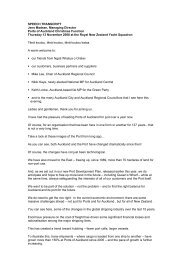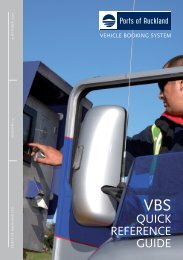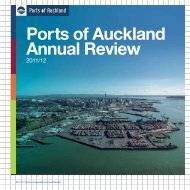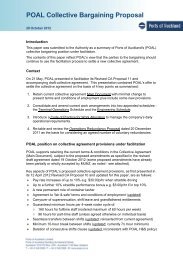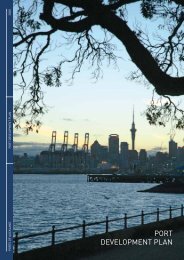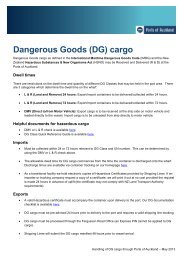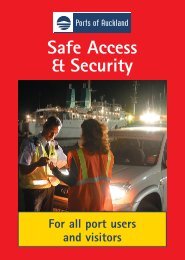0204060810121416Market Review<strong>Ports</strong> <strong>of</strong> <strong>Auckland</strong> Annual Review <strong>2008</strong>This year was notable for continued market volatility and turbulenceas competing shipping lines rationalised services in an effort to savecost and achieve greater efficiency.Overall, <strong>Ports</strong> <strong>of</strong> <strong>Auckland</strong> was a net winner in a raft <strong>of</strong> line and servicechanges during the year. While <strong>Auckland</strong> lost CMA CGM’s Nemo andPanama service calls and those <strong>of</strong> Gold Star Line’s trans-Tasman service,we retained and won others that more than outweighed the losses.Hamburg Sud and Maersk Line rationalised two <strong>of</strong> their key servicesover <strong>Auckland</strong>, electing to jointly operate a 12-vessel weekly serviceto Australasia, East Coast North America and Europe. In addition, fiveshipping lines (Pacific International Lines, Orient Overseas ContainerLines, Mitsui O.S.K. Lines, NYK Line and MISC Berhad) revamped theirtwo-loop South East Asia Service into single-loop, bringing larger2,800 TEU vessels to <strong>Auckland</strong> each week.The uplift in container volumes, anticipated as a result <strong>of</strong> thesechanges, began to be felt in late June <strong>2008</strong>.Meanwhile, bulk and breakbulk volumes through General Wharvesincreased slightly (excluding Wynyard Wharf volumes). There wasnotable strength in the bulk cargoes trade and a slight increasein vehicle imports ahead <strong>of</strong> new vehicle emission rules introduced inJanuary <strong>2008</strong>.Overall, ship calls stayed much the same, in keeping with industrytrends to fewer calls by larger ships, and there was a pleasing increasein cruise ship calls, up more than 40% to 70.Market OutlookWe anticipate ongoing market volatility as shipping lines deal withincreasing external pressures. Steel, fuel and crew costs haverocketed to new highs. However, the impacts <strong>of</strong> the global economicslowdown are yet to be fully realised. Projections for global shipping,typically a high-growth sector, are relatively bleak. It is unlikely theindustry will experience organic growth in the coming years to theextent it has done previously.Therefore, while the 2009 financial year has started well, weexpect a tailing <strong>of</strong>f in volume growth as the effects <strong>of</strong> the globaleconomic slowdown are felt. Overall we expect volumes to settle ata similar level to that <strong>of</strong> <strong>2008</strong>. Meanwhile, the cruise business isanticipating a very busy season on par with last year, with in excess<strong>of</strong> 70 calls anticipated.We also expect that the international trend to hubbing will driveincreased coastal shipping around New Zealand. We welcome theGovernment’s Sea Change strategy to reinvigorate the trade and lookforward to more coastal services in 2009. Once better established,coastal shipping will provide shipping lines with more supply chainchoices and facilitate a greater focus on larger vessels. This trendis likely to be positive for <strong>Ports</strong> <strong>of</strong> <strong>Auckland</strong>, both at the Waitemataseaport and in Onehunga.Volume TrendsOne <strong>of</strong> the most interesting trends <strong>of</strong> the year was a 55.5%increase in trans-shipments. The dramatic increase can be attributedto the ongoing service consolidations experienced since 2006,and provides further evidence <strong>of</strong> an emerging hubbing structurefor New Zealand, with <strong>Ports</strong> <strong>of</strong> <strong>Auckland</strong> at the heart <strong>of</strong> thedeveloping trend.While overall container volumes reached a pleasing record high,growth was in fact less than had been anticipated. Import volumeswere particularly affected in the second half <strong>of</strong> the year, while UpperNorth Island drought conditions and a high New Zealand dollars<strong>of</strong>tened export volumes.
OPERATIONAL HIGHLIGHTSThe <strong>2008</strong> financial year was an exceptionallybusy one for Port operations, with containervolumes at record highs, across-the-boardimprovements in key productivity measuresand a number <strong>of</strong> major projects reachingimportant milestones.VolumesTotal container volumes were up 8.8% for theyear to a record high <strong>of</strong> 840,993 TEU, withtrans-shipment volumes increasing by 55.5%.Full import volumes were up 3.0% and full exportcontainer volumes down 2.7%.Bulk and breakbulk volumes (excludingWynyard Wharf volumes) increased 2.4%. Vehicleimports were also up slightly as importers movedahead <strong>of</strong> new vehicle emission standards that tookeffect on 1 January <strong>2008</strong>.While the Port handled slightly fewer shipcalls, the cruise business showed good growth.The <strong>2007</strong>/08 season was <strong>Auckland</strong>’s biggest yetwith 70 calls by 30 cruise ships.ProductivityVery encouraging progress was made in lifting portproductivity to world class levels. The containerterminals recorded a 5.7% increase in cranemoves per hour, a key productivity measure. Thisimprovement was particularly pleasing given therecord high container throughput and increase intrans-shipment volumes. Across-the-boardimprovements were also recorded in ship hoursin port, ship turnaround, staff hours per containerand truck turnaround measures.PeopleAn increased focus on our people was a key priorityfor the year, a strategy that will continue in 2009.Key changes and initiatives included:• a major values and culture change programme,Compass, in which around 440 Port staffparticipated during the course <strong>of</strong> the year• the introduction in May <strong>2008</strong> <strong>of</strong> the ProductivityBonus Programme, a self-funding staff bonus plan,to reward productivity gains for operational staff• the amalgamation <strong>of</strong> the Bledisloe and Fergussoncontrol and planning teams, consistent with anew ‘one terminal’ philosophy.For more information on these initiatives see the<strong>2008</strong> Sustainability Review.Equipment and TechnologyTen new twin-lift straddle carriers were addedto the Port’s fleet during the year, cementing the fleetas the country’s newest, largest and most efficient.A range <strong>of</strong> strategic technology projectswere also advanced. A comprehensive process toprocure a new Terminal Management System wascommenced during the year and a project teamestablished. The project is one <strong>of</strong> the largest <strong>of</strong>its kind ever undertaken at a New Zealand port,and will be a key enabler for further improvementsin capacity, customer service and productivity.In November <strong>2007</strong>, after extensiveconsultation with the freight industry, weintroduced a Vehicle Booking System (VBS) at theFergusson container terminal. The system has beeninstrumental in helping the Port cater for increasedtruck volumes while simultaneously reducingturnaround times, and has since been introducedat the Bledisloe container terminal.New technology at the General Wharves isspeeding up the supply chain for imported secondhandvehicles. <strong>Ports</strong> <strong>of</strong> <strong>Auckland</strong>’s proprietaryVehicle Entry User System (VENUS) involves theuse <strong>of</strong> handheld barcode readers to identify andtrack vehicles, while MAF, Customs and bill paymentclearances are recorded on a web-based service.The paperless system allows transport operators tocollect vehicles from the wharves quickly and easilyusing a pin number.Other new systems, such as SCADA, a real-timemonitoring system for fuel and energy consumption,are enabling efficiency improvement and savings.InfrastructureIn August <strong>2007</strong>, the deepened shipping lane was<strong>of</strong>ficially opened (see pages 4 and 5 for moreinformation). Another major milestone was reachedwith the conclusion <strong>of</strong> Stage One <strong>of</strong> the Fergussoncontainer terminal extension. The additional5.8-hectares provided by this reclamationsubstantially increases our container-handlingcapacity, enabling greater operational efficiency.Meanwhile, construction began on the new GoldenBay Cement facility in the eastern Port, where this vital<strong>Auckland</strong> industry will relocate at the end <strong>of</strong> 2009.23MINUTES Average truckturnaround440staff attended compass training10new straddle carriers




